Panasonic Viera TH-42PZ700B 42in Plasma TV Review
Panasonic Viera TH-42PZ700B 42in Plasma TV Review
Panasonic breaks new ground with a 42in 1080p plasma TV.
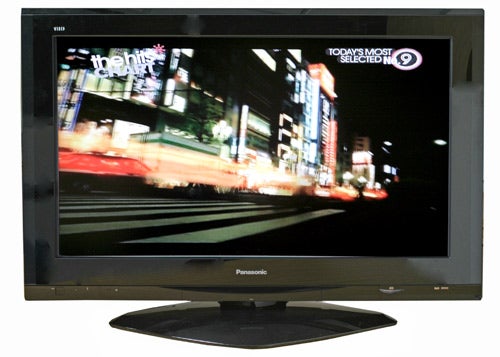
Verdict
Key Specifications
- Review Price: £1767.00
I first saw this TV at the Consumer Electronics Show back in January and I’ve been hassling Panasonic about getting a review sample ever since. You see, the TH-42PZ700B represents a landmark in the plasma high definition TV arena, and it strikes a hefty blow for plasma technology in the face of better and better specified LCD competition. What makes this plasma TV so special? It’s the World’s first 42in 1080p plasma screen – something that Panasonic’s engineers should be very proud of.

If you’re wondering why I’m so impressed with a 42in plasma screen sporting a resolution of 1,920 x 1,080, let me explain. With an LCD screen, raising the native resolution is a relatively easy operation, it’s just a case of adding more pixels to a piece of glass and reducing the pixel pitch. Because LCD is a transmissive technology, the only thing that each pixel has to do is twist – twist one way to let light through, twist the other way to block light out. Things are very different with a plasma screen though, since plasma is an emissive technology, meaning that each pixel emits light. This means that each and every pixel is actually a tiny plasma chamber and therefore resolution is limited to how small those plasma chambers are.
For a long time if you wanted a Full HD plasma screen, you needed to have a seriously big house, since squeezing 1,920 x 1,080 plasma chambers in, resulted in screen sizes of 60in and above. The problem with reducing the size of the plasma chambers is that the brightness level also ended up being reduced, thus negating one of plasma’s advantages over LCD. However, Panasonic has clearly put a huge amount of R&D behind its plasma chamber design, because not only has it managed to squeeze 1,920 x 1,200 pixels into a 42in screen, but the brightness doesn’t appear to have suffered as a result.
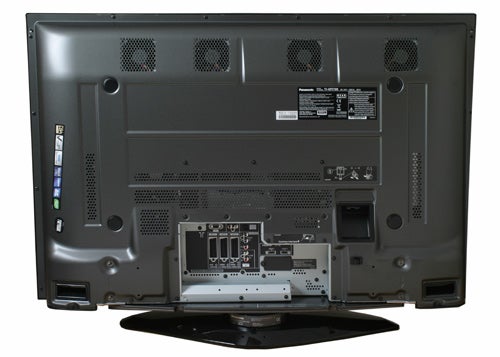
Like the Panasonic TH-37PX70 that I reviewed back in May, the TH-42PZ700B is adorned with a piano black finish, rather than the matt silver of last year’s Panasonic TVs. There’s no denying that this TV looks good, and even the side mounted speakers are fairly unobtrusive due to the overall black finish. Like most Panasonic TVs, you can purchase the TH-42PZ700B as a wall mountable unit, with a two shelf cabinet or with a pedestal stand, as seen here. The stand hasn’t changed much over previous generations, but that’s no bad thing – it offers a very solid base and smooth panning. The black fascia is broken only by a rather discreet Panasonic logo below the screen, and a small Viera logo at the top left.
Connection wise, Panasonic has pushed the boat out with this TV. Kicking things off are three HDMI 1.3 ports – not only will you be able to hook up more high definition kit than with most other 42in TVs, but you’ll also be able to take advantage of high bit depth, Deep Colour content once discs appear that support this feature of course. There’s also a component video input for analogue HD sources like an Xbox 360, as well as D-SUB port for hooking up a PC. You also get three Scart sockets (two RGB), analogue audio in for the component video and D-SUB connections and analogue audio out. There’s also optical digital audio out, allowing you to pass through the digital audio from the HDMI inputs to a suitable external amp or processor.
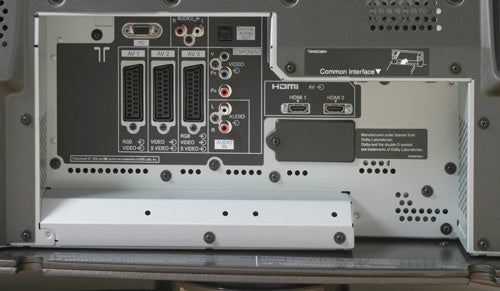
At the front of the TV below the screen is a flap that hides even more connection options. Here you’ll find one of the three HDMI ports, conveniently placed for anyone with a high definition camcorder. Also under the flap is an S-Video input, composite video input and analogue audio inputs. Finally there’s a 3.5mm headphone socket, just in case you want to turn the sound up without disturbing the rest of the household. The only other connection is a CI slot for adding subscription channels to the built-in digital tuner.
Also at the front is another small flap that hides an SD card slot, which also accepts SDHC cards. You can show slideshows of digital still images from an SD card, while also streaming video in both MPEG-2 and AVC-HD formats. Interestingly you can only read from SD cards, unlike the Panasonic TH-37PX600 which could record TV to the SD card as well.
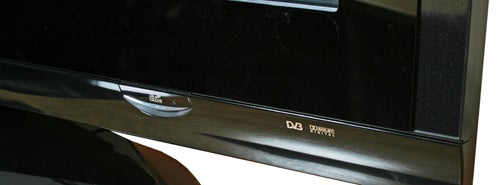
With its Full HD 1,920 x 1,080 panel, this TV looks like the perfect plasma solution for anyone with a normal sized living room. But Panasonic hasn’t quite ticked all the boxes that I would have hoped with the TH-42PZ700B. This TV will, of course, accept a 1080p signal, but strangely it will only accept 1080p 50 and 60, with 1080p 24 completely off the menu. This decision is all the more bizarre when you consider that Panasonic’s PT-AE1000E projector will happily accept a 1080p 24 signal. Another rather odd quirk is the fact that TH-42PZ700B won’t accept a 1080p signal through its component video input – for some reason component video maxes out at 1080i.
There are some pretty useful features to be found in the TH-42PZ700B’s menus, but thankfully Panasonic has made sure that it doesn’t blind the user with science, with all the options fairly easy to understand and implement. There’s a Viewing Mode selection, which is something that’s more often found on projectors, but that doesn’t mean that it’s not useful, far from it in fact. You can choose from Dynamic, Normal, Movie and Auto modes, with each one offering different contrast, brightness, sharpness, colour settings etc. The really clever part is that you can assign particular viewing modes to particular inputs – so, if HDMI 1 is your HD DVD player, you’ll probably want to assign Movie to it, and if HDMI 2 is your PS3, you’ll probably assign Dynamic to it to get those super-vibrant colours.
There’s a P-NR (Picture Noise Reduction) option with Off, Min, Mid and Max settings. For the most part the Min setting was more than capable of dealing with any unwanted noise and artefacts, and even then, the source had to be pretty poor in the first place. Also well worth a mention is the Picture Overscan setting, which allows you to switch off the overscanning circuitry, essentially giving you a 1:1 pixel mapped image – exactly what you want from your 1,920 x 1,080 line sources.
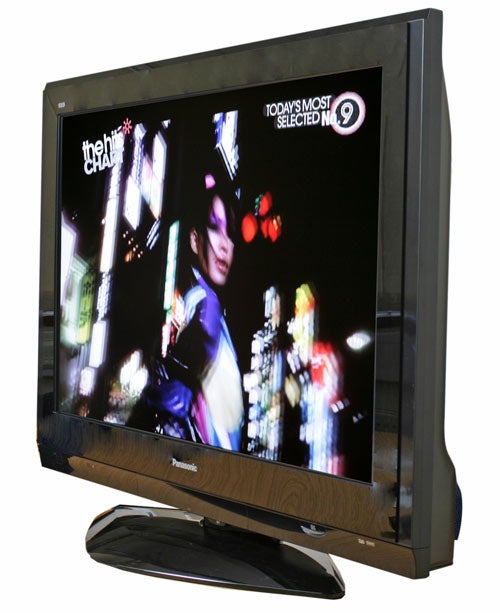
Panasonic plasmas already have a great reputation when it comes to image quality and the TH-42PZ700B just enhances that reputation further. I’d go as far as saying that the pictures from the TH-42PZ700B put every other 42in HDTV in the shade, it really is that good. I decided to feed this Panasonic some top drawer HD content to get the ball rolling, in the form of The Matrix Reloaded on HD DVD – the image quality on this disc is nothing short of amazing, especially when pumped out at 1080p from a Toshiba HD-XE1 player. Watching Agent Smith address Neo before that incredible fight highlighted the level of detail that the TH-42PZ700B can achieve. Seeing Neo’s face clearly reflected in Smith’s sunglasses while he talks, added a true sense of depth and immersion to proceedings. And once the fight starts, it’s clear that this TV doesn’t lose its grip on fine detail when faced with fast moving action – Neo’s battle with hundreds of Smiths has never looked so good. Likewise the chase on the freeway had me holding my breath in anticipation, meanwhile all work in the office ground to a halt as the whole team marvelled at the pictures emanating from this TV.
Turning to the HD DVD release of Brotherhood of the Wolf, it became clear that the TH-42PZ700B can also do a sterling job with HD sources that aren’t quite so pristine. Although this is a great HD transfer, the original movie is somewhat grainy in the first place, so it’s never going to look as clean as The Matrix discs. That said, the level of detail resolved by this Panasonic is still very impressive. The opening fight scene in the pouring rain showed off the TH-42PZ700B’s ability to resolve every rain drop and every splash as Mani dispatches each of the renegade soldiers. And even with all the rain being so beautifully resolved, there’s no hint of detail loss, even during some of the more spectacular moves. While in more sedate scenes, the level of detail and richness of lighting and colour is spectacular. The characters’ hair looks particularly impressive, with each strand easily discernable from the next, while in cold scenes each and every piece of dialogue is accompanied by misty breath, adding to the atmosphere.
And I should point out that the presence of Monica Bellucci in both the high definition test movies was completely coincidental, honestly. She did, of course, look stunning on this TV.
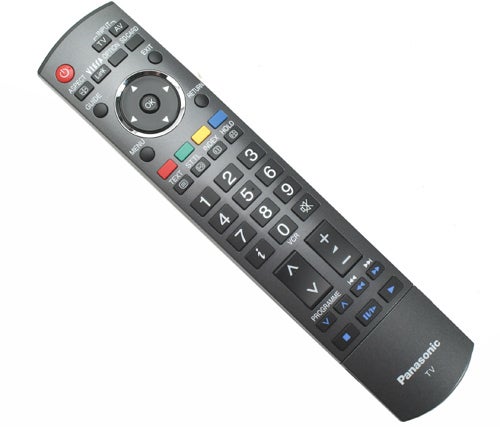
High definition gaming looks no less spectacular, with Ninja Gaiden Sigma on the PS3 looking bright, vivid and visually stunning. The TH-42PZ700B lends itself beautifully to games like this with bright colours and fluid movement, but it’s not all about bright and vivid scenarios. Firing up Gears of War on the Xbox 360 showed that the black levels, as expected, are first rate on this TV. Few games are darker and more foreboding than Gears, and the TH-42PZ700B managed to render those dark environments perfectly, without any loss of detail in low light areas. In fact, once I sat down and started playing Gears, I found it almost impossible to tear myself away – this TV makes the experience so immersive!
Of course one of the toughest tests for any TV with a 1,920 x 1,080 panel is making standard definition sources look good. When you’re having to scale standard definition signals so much you better hope that your TV has a good picture processing engine. Luckily for the TH-42PZ700B, it looks like Panasonic’s V-Real Pro 2 engine is well up to the task. Even when displaying some truly awful Freeview fodder at woefully low bit-rates, the TH-42PZ700B gave a good account of itself. In fact, apart from a bit of dot crawl on particularly poor Freeview sources, it’s hard to believe that so much scaling is going on inside this TV. So, even if you predominantly watch SD content, it will still look good on this Panasonic – although it would be a crime not to watch high definition sources on a TV like this.
Despite the fact that I would expect anyone buying a TV like this to have a full surround sound system, the speakers in the TH-42PZ700B do give a good account of themselves. With surround switched off the sound is solid, with enough low frequency talents to give big explosions suitable gravitas. You also have the option of selecting both Simulated Surround and SRS TruSurround XT, both of which provide a convincingly wider soundstage, but are obviously still no substitute for a real multi-speaker system. On the whole though, as far as built-in speakers go, the TH-42PZ700B is up there with the best.
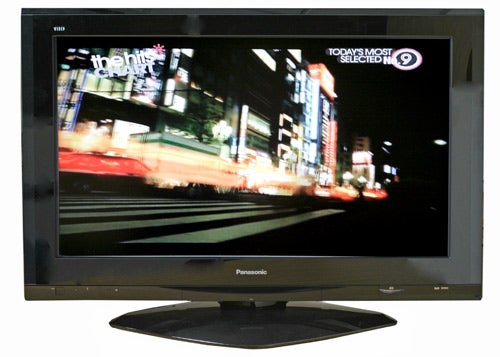
Considering how much R&D must have gone into this TV, it comes as no surprise that it’s not the cheapest 42in HDTV on the market. With a street price of £1,767 including VAT, it’s over twice the price of Toshiba’s 42X3030D, but then the picture quality is, quite simply, on another level. Whether you think the Panasonic is worth the money depends on your budget and how discerning you are when it comes to picture quality.
”’Verdict”’
Panasonic has created something very special with the TH-42PZ700B. Not only is this the first 42in plasma TV to sport a 1,920 x 1,080 panel, but it also exhibits superior picture quality to any 42in HDTV I’ve seen. Feed this screen high quality, high definition sources and I guarantee you’ll be blown away, but arguably even more impressive is how well it handles low quality SD signals.
It’s a shame that the TH-42PZ700B doesn’t support 1080p 24, or in fact 1080p at all over component video, but even that can’t spoil what is a truly stunning high definition TV. Yes it’s a lot more expensive than a 42in 1080p LCD TV, but if you can afford the extra cash, you definitely won’t be disappointed.
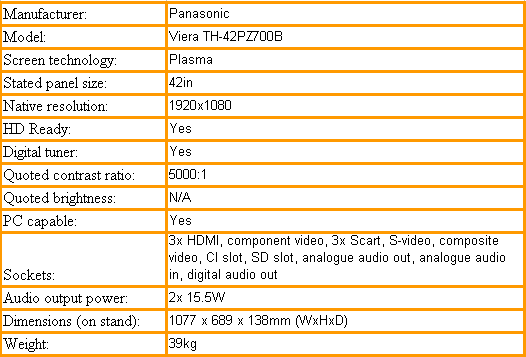
How we test televisions
We test every TV we review thoroughly over an extended period of time. We use industry standard tests to compare features properly. We’ll always tell you what we find. We never, ever, accept money to review a product.
Trusted Score
Score in detail
-
Value 8
-
Image Quality 10
-
Sound Quality 9

